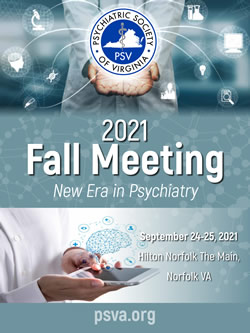Summer 2021 Issue |
|
Controversies in Psychiatry
On the Outside Looking In: The Impact of Psychiatric Diagnoses on Marginalized Populations
By Jonathan Punzi, MD
VCU Health System
Department of Psychiatry
The DSM has often been referred to as “the Bible of psychiatry”. First released in 1952, it has since undergone multiple revisions and editions up to the current DSM 5, which was released in 2013. It has long served as the primary source of diagnostic classification for psychiatric disorders in the U.S. However, the word “Bible” is a bit of a misrepresentation.
Referring to it as such implies that it is the written representation of some universal psychiatric truths. The real truth is that the DSM is more akin to an encyclopedia. It is a living document, created and updated by experts as a result of scientific growth. What constitutes a psychiatric disorder is unavoidably tied to cultural and social norms, which are in constant flux. As such, any attempt to classify such disorders will be influenced by these external factors. Unfortunately, throughout history various groups of people have been marginalized by society, and in some cases, this has been perpetuated by labeling such groups as psychiatrically disordered. This is not to say that the creators of the DSM are to blame. In fact, many updates to the DSM have actively attempted to reverse some of these instances. Given the ubiquity of the DSM, it is worth reviewing some of these historical examples and examining whether any current diagnoses are problematic.
Pathologizing groups based on societal views long predates the DSM. One of the earliest examples of such a phenomenon is that of hysteria. Initially described in ancient Egyptian papyri, and later elaborated upon in the era of Greco-Roman medicine, hysteria encompassed a wide spectrum of symptoms which were almost exclusively applied to women. Notable symptoms included mood lability, a sense of suffocation (globus hystericus), dissociation, catatonia, and a multitude of neurologic and somatic symptoms. These symptoms were initially thought to be caused by a detached uterus or “wandering womb” which roamed the body causing dysfunction of various organ systems. In the middle ages, demonic possession or witchcraft were thought to be the culprits.
As medicine began to advance in the 1600s, the etiology was thought to be related to a constitutional disturbance. In the 1800s it was proposed to be either a brain disorder by neurologists, or a uterine or ovarian disorder by gynecologists. The “treatments” were just as varied throughout history, and included pelvic massage, bleeding, purging, hypnosis, various medications, exorcism, burning at the stake, clitoral amputation, and oophorectomy. It was only in the early 1900s that hysteria was related to early trauma and unconscious conflict, thanks in large part to Dr. Freud. Although the diagnosis of hysteria never made it into the DSM, its influence can be found in some present-day disorders including somatization disorder, conversion disorder, dissociative disorders, and borderline personality disorders. Most of these share some common traits with hysteria including female predominance, dramatic presentations, pseudo-psychotic symptoms, mood disturbance, identity disturbance, and often tumultuous upbringings.
Because of these similarities, providers may be tempted to flippantly apply labels such as borderline personality disorder to women that present under similar circumstances, even if they don’t meet the full diagnostic criteria. Such labels are much less likely to be applied to men with similar presentations. Not only does this continue to pathologize women, but it further stigmatizes individuals that are truly suffering from borderline personality disorder.
Sexual orientation has also been a source of marginalization, both by society and psychiatry. Heterosexuality has long been treated as normal, and alternative sexual orientations have long been stigmatized despite their prevalence. Homosexuality was described as a psychiatric disorder going back to at least the first or second century AD. Unlike hysteria however, homosexuality did in fact persist into the DSM-I in 1952 under the umbrella of “sexual deviation” alongside things such as “transvestism, paedophilia, fetishism, and sexual sadism”. This was carried forward into the DSM-II in 1968. It should be noted that including homosexuality in the DSM was likely not done with malicious intent. Homosexual individuals often suffered terribly at the hands of society via hate crimes and legal persecution. Classifying homosexuality as a disorder may have been in part an attempt to prevent some of this suffering. If it was a disorder, it was thought that it could be treated, and such individuals could then lead fulfilling lives.
Unfortunately, this did not end up being the case, and societal views toward homosexuality did not improve. If anything, it may have led to people feeling more justified in their negative views toward homosexuals. Even worse, homosexual individuals were subjected to various “treatment” modalities including conversion therapy, aversion therapy, lobotomy, and ECT. Scientific views toward homosexuality began to shift in the 1950s, thanks to the work of Alfred Kinsey who demonstrated that homosexuality was not uncommon, and Evelyn Hooker who demonstrated that homosexuality was not associated with psychological dysfunction.
The results of their research, along with increasing pressure from gay rights advocates, helped kickstart the circuitous process that ultimately led to the removal of homosexuality from the DSM. The process was spurred forward by the combined efforts of several young, liberal-minded APA members, some of whom were homosexual themselves. Unfortunately, it was not without speed bumps, as the idea was opposed by a handful of members who maintained homosexuality was a disorder that could be treated. This led to a drawn-out battle characterized by the formation of multiple committees, a ruling by the board of trustees in favor of removal, and ultimately a vote by the APA membership upholding the ruling. When the DSM-III was released in 1980, homosexuality had been removed. The events of this process now serve to showcase the influence that personal and societal views can have on psychiatric classification.
Finally, it is important to examine whether any current psychiatric diagnoses continue to impact marginalized populations. One such diagnoses may well be gender dysphoria. Although the release of DSM-III was notable for the removal of homosexuality, it also introduced the idea of gender identity disorders. Although cross-dressing has previously been listed in DSM-I and DSM-II as transvestism, DSM-III was the first to codify gender variance as a disorder.
Much like homosexuality, this served to pathologize an entire population of people, in this case by labeling gender nonconforming individuals as disordered. The diagnosis underwent multiple permutations and was ultimately replaced in DSM 5 by gender dysphoria. This would appear to be a step in the right direction, as the diagnosis is no longer based solely on ones’ gender not conforming with sex assigned at birth. Instead, the diagnosis is applied only if a gender nonconforming individual experiences significant distress as a result.
However, this raises the question, whether or not his dysphoria is intrinsic to the individual which would warrant a psychiatric diagnosis, or whether it is a result of the ongoing social stigma surrounding gender nonconformity. Many of these individuals are the victims of hate crimes, and they are offered very little in the way of legal protection and equality, particularly on the federal level. Labeling these individuals with a psychiatric diagnosis could be interpreted as implying that the issue lies with the person rather than their environment.
On the flipside, a firm diagnosis is often necessary in order for these individuals to receive gender-affirming treatments such as hormones and surgery. It seems the ICD may be addressing this with the release of ICD-11 with the creation of a new category for sexual health. If that occurs, the ICD diagnosis of gender incongruence will likely be moved out of the mental health category and into the new one. This would serve to acknowledge that gender non-conformity is not a psychiatric disorder while still allowing for billing and coding. Similarly, it is worth considering whether gender dysphoria truly warrants inclusion in the DSM, or whether it can be removed with the understanding that although the experience of dysphoria is very real, it is not necessarily an individual issue but rather a societal one.
Psychiatry as a field, and the DSM as a resource, have made great strides over the past several decades, but there is still work to be done. By determining certain clusters of symptoms as disorders, psychiatry plays a pivotal role in what is considered normal and abnormal by society. As such, it is important to maintain vigilance as the field continues to grow, to ensure that diagnostic classifications are always based on the best available evidence, and that diagnoses do not unfairly stigmatize any populations. Care should also be used on the provider level to ensure diagnoses are based on thorough history taking as opposed to surface impressions. This way, treatment remains focused on relieving suffering, which is truly the heart of psychiatry.
YOUR NEWSLETTER IS NOW AVAILABLE ON YOUR SMARTPHONE AND TABLET!
JOIN PSV TODAY!
PLAN NOW!
PSV 2021
FALL MEETING
September 24-25, 2021
Hilton
Norfolk The Main
Norfolk, VA
APA Find a Psychiatrist
Are you accepting new patients?
Opt into APA’s Find A Psychiatrist database. To view the functionality or opt-in,
CLICK HERE
FYI: A link for this option has been added to the PSV website. Select the About button and then Find a Psychiatrist from the drop down.




